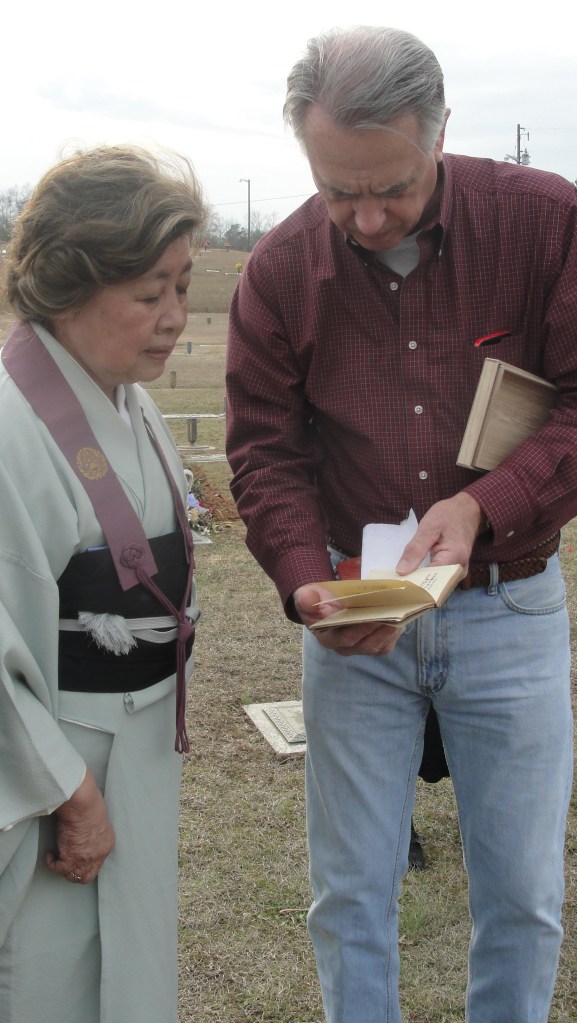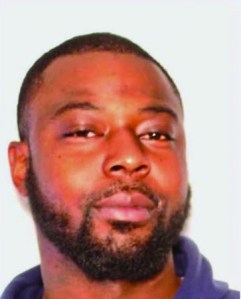Japanese woman visits Milledgeville to pay homage to late war hero
Published 1:15 pm Monday, April 6, 2015

- Hashimoto visits with Veal's family and friends at his gravesite.
Deeply ensnared in the throes of WWII, a young Frank Veal and his few remaining comrades were elated when the ceasefire reached the Philippines on Aug. 15, 1945. Soldiers on all sides returned home with their own horrors, but Veal returned with something more tangible that would haunt him for the next 55 years.
Some months prior, on the morning of June 23, 1944, a 22-year-old Veal and the few remaining brothers in his company sat holed up atop a hill they knew only at the time as Lone Tree Hill. A dense fog and the bodies of their comrades surrounded the nine enduring members of the 6th Division.
Trending
From the fog arose the morning’s 18th wave of enemies with a blistering scream of “Banzai!” From his shallow hole dug into the coral, Veal looked up to see a howling Japanese soldier above him. Before the young American could react, one of the many whistling bullets found the assailant and the enemy fell atop Veal, loosing his final breath and passing away. What was moments before a faceless challenger vying for Veal’s life, was now a peer, looking up at him with the same lifeless eyes shared by his fallen Allied comrades. Veal guessed the soldier, a mere boy compared to himself, to be around only age 18.
At the time, soldiers were asked to collect any information of potential strategic value from fallen enemies. Rifling through the young man’s pockets, Veal uncovered a billfold and a small journal. Opening the journal, Veal found it indecipherable. No one in his company could translate the Japanese.
Nine months later, news came that everyone was going home. Veal still had the young man’s belongings. They made their way back to America with him and would stay, undisturbed, in his possession for several decades before a fortuitous string of connections would bring the journals out of storage.
Some years ago, Veal’s grandson mentioned the grave keepsakes to his father-in-law, Bob Yaden. Yaden’s friend, Bill Geiger, was a pilot who frequently flew to and from Japan. Suddenly realizing an opportunity he had yet to ever consider, Veal arranged to have a photocopy of the diary sent to Japan for translation with Geiger’s friend, Isao Nonomiya.
“I’d never really thought of having it translated,” Veal said in an 2007 interview. “And without those two men (Yaden and Geiger) none of this might have come about.
The results of the translation showed that the billfold and journal belonged to a Sakujiro Aida, a young man of 17 from Yamagata City. The journal was full of the ponderings of a juvenile soul, lost in the giant scheme of warfare. What was once only a body to Veal suddenly became an equal; Sakujiro was a scared, confused man, more child than adult, who wanted to go home to his family and leave the wretched fields of battle.
Trending
Sakujiro filled his journal with poems and reflections on his mother’s gentleness, his favorite music and the addresses of friends back home in Yamagata City.
“My dear mother, my dear sister, although I haven’t written a letter, I’m writing my thoughts for you in the sky,” he wrote.
Seeing the mind of Sakujiro in similar places to his own at that age, Veal was forced to realize how human his opponents were in that war. Bullets ripping past one’s head can make one forget that the person on the other end of the barrel has a family.
“Sakujiro seems to have a deep love for his mother and sister and others in his family. I think he was a lot like me in that he would have liked to go home,” said Veal.
“Once I had a name, I knew I had to do the right thing. Once I found I had a connection, I felt I had to return the wallet and diary.”
The very next week, an article on the diary’s return to Japan ran in the Yomiuri Newspaper. Shoshiti and Taeko Aida, bother and sister-in-law to Sakujiro Aida, promptly found their way into contact with Veal. With the help of the pilot, Geiger, an exchange was made, and finally, after more than 50 years, the journal and wallet made it back to their rightful family in a reunion that brought Sakujiro’s friends and family in from miles away.
In the many years since the war, Sakujiro’s family hadn’t known what happened to him in the war. The mystery of his presumed death had haunted the family, and the closure found in the journal left them with a peace of mind that Sakujiro was not forgotten entirely by the war.
Veal chose to not participate directly in the overseas exchange as he rightfully “didn’t want to put a face on this thing.” Upon receiving the journal, Sakujiro’s family hosted a Buddhist funeral service for their lost brother, which left several of the Aida’s in disrepair. Participants in the ceremony noted that the air in the room felt as though Sakujiro had unexpectedly died earlier that week. Without knowing the boy’s fate, the family had never been able to properly send off their brother.
Letters exchanged between the family and Veal were filled with vehement thanks from both sides for the closure provided. The Aida’s thanked Veal for bearing witness to Sakujiro’s death with honor and for helping them put him to rest after all this time.
Now, more than a decade later, the journal is making a return to relevance. A close family friend of the Aida’s, Tasuna Hashimoto, who was in attendance when Geiger returned the journal to the family, is writing a book about the journal and its circumnavigation of the globe.
Hashimoto, of Narita, is leader of that city’s UNESCO Ladies Group. Her husband is Archbishop of the Narita-san Temple, on of the most well-known, important Buddhist temples in Japan.
Seeing the courage Veal drew from his faith and his strong hate for war, Hashimoto found herself with a great deal of respect for the man who returned the journal. Hashimoto specifically sites Veal’s writing to Yaden on war and faith: “Sometimes now when I think back I know my faith helped with courage enough to survive. I found courage came when your fear has said its prayer. There is one thing I do know; the world’s warlords and politicians must find a way to solve their differences without war. For war is not a sign of wisdom but a sign of insanity.”
As a means of starting her writing process in good graces with all involved, Hashimoto made the trek to America on March 8 to pay homage to Veal’s grave. Jetlagged and staggered by the size of the graveyard, Hashimoto approached Veal’s grave with the somber thankfulness of every friend and family member of the Aida’s.
A ceremony of incense burning and placing flowers at the grave was accompanied with a deep, silent prayer, thanking Veal for the service he paid to the Japanese people and victims of war everywhere. On his grave were placed the two purple hearts and three silver stars given to Veal during his tour.
In attendance were family and close friends to the Veals, including Frank’s two children, Mike Veal and Phillis Brown, and their spouses, the Geigers and the Yadens. Beverly Heiberg, and a flight attendant from California, has been a friend of Hashimoto for 30 years and accompanied her in her long travels from Japan to America.
With her, Hashimoto also brought the journal and billfold, presenting them on Veal’s grave for a moment as well. Now, the mementos of Sakujiro’s short life sit, protected, in the Narita-san Temple.
In correspondence with Hashimoto and her translator, they wrote “Mrs. Hashimoto hopes to let our young people know how much they owe our predecessors for what they enjoy today; peace and prosperity which they often take too much for granted. The book will be a good reminder of the hardships both American and Japanese soldiers went through during the war.”
As another memorial to Veal’s strong soul and good deeds, Montpelier Methodist Church in Milledgeville dedicated the Frank Veal Education Center to his memory. Here, Sunday School rooms and a fellowship hall pay homage to the faith Veal said got him through the war with his sanity intact. Hashimoto enjoyed seeing where Veal would’ve liked to do his reflections and prayers, knowing they are of different faiths each with the same goal.
In his first letter to the Aida’s, Veal wrote “I don’t know what faith you have, but whatever faith, trust it. You can find comfort”
Veal’s daughter, Phillis spoke for everyone at the grave that day in saying “It’s great that two cultures can come together even over something so horrible.”
Now, Hashimoto will return home to finish chronicling the journey of the journal and use her book to further what Frank Veal said in his writing, that war is insanity.






